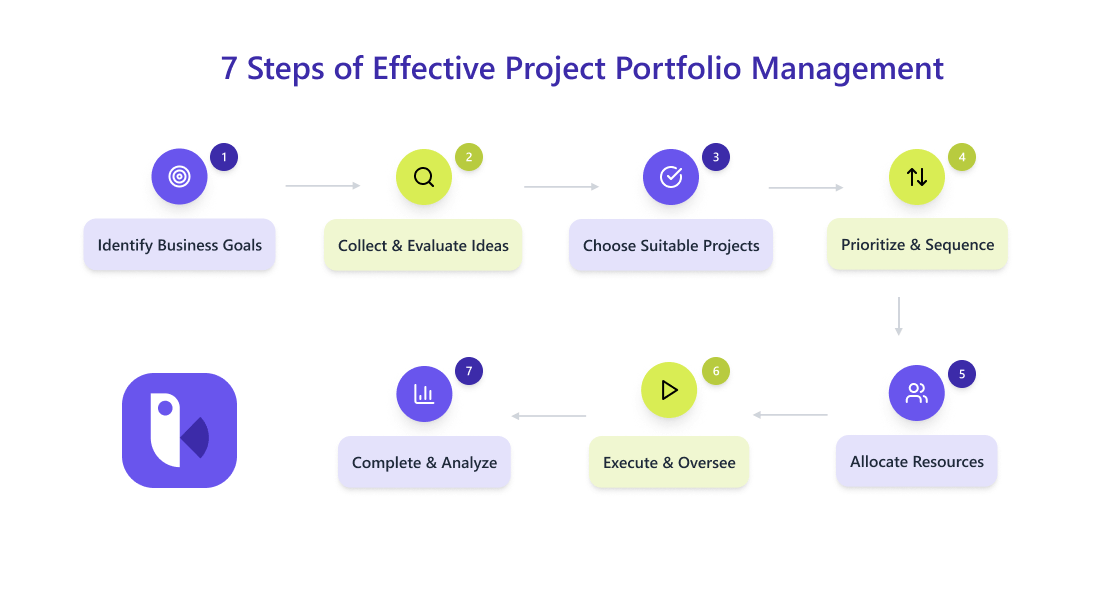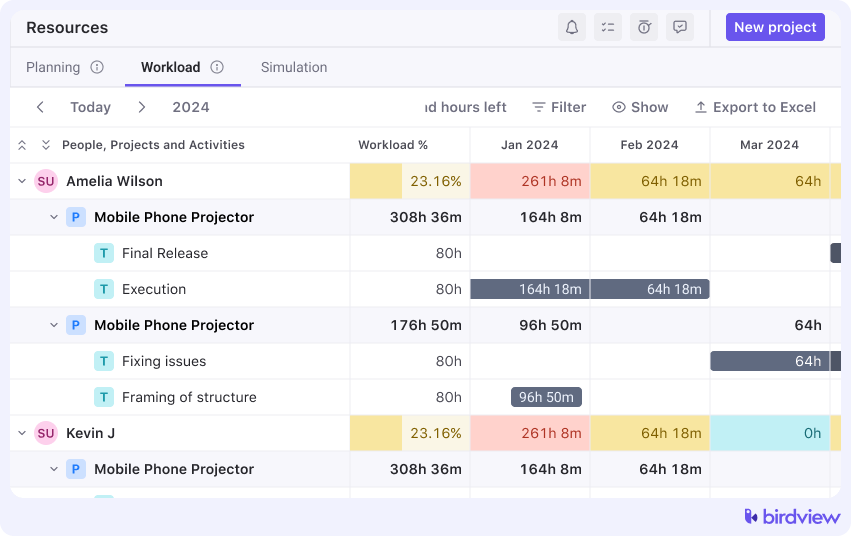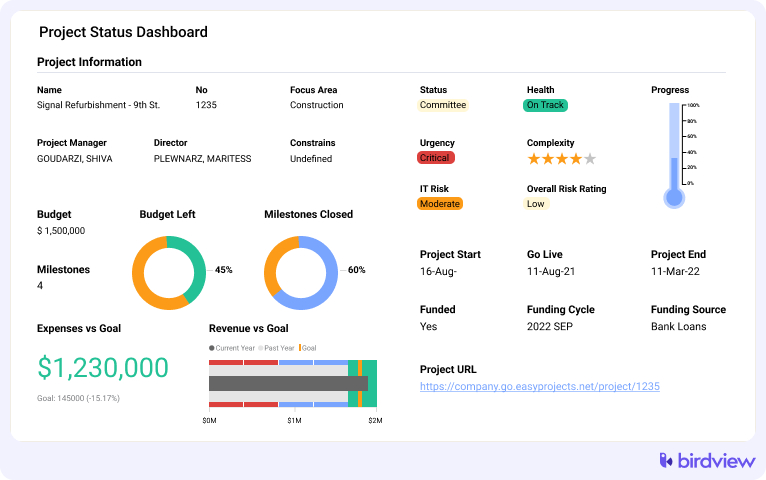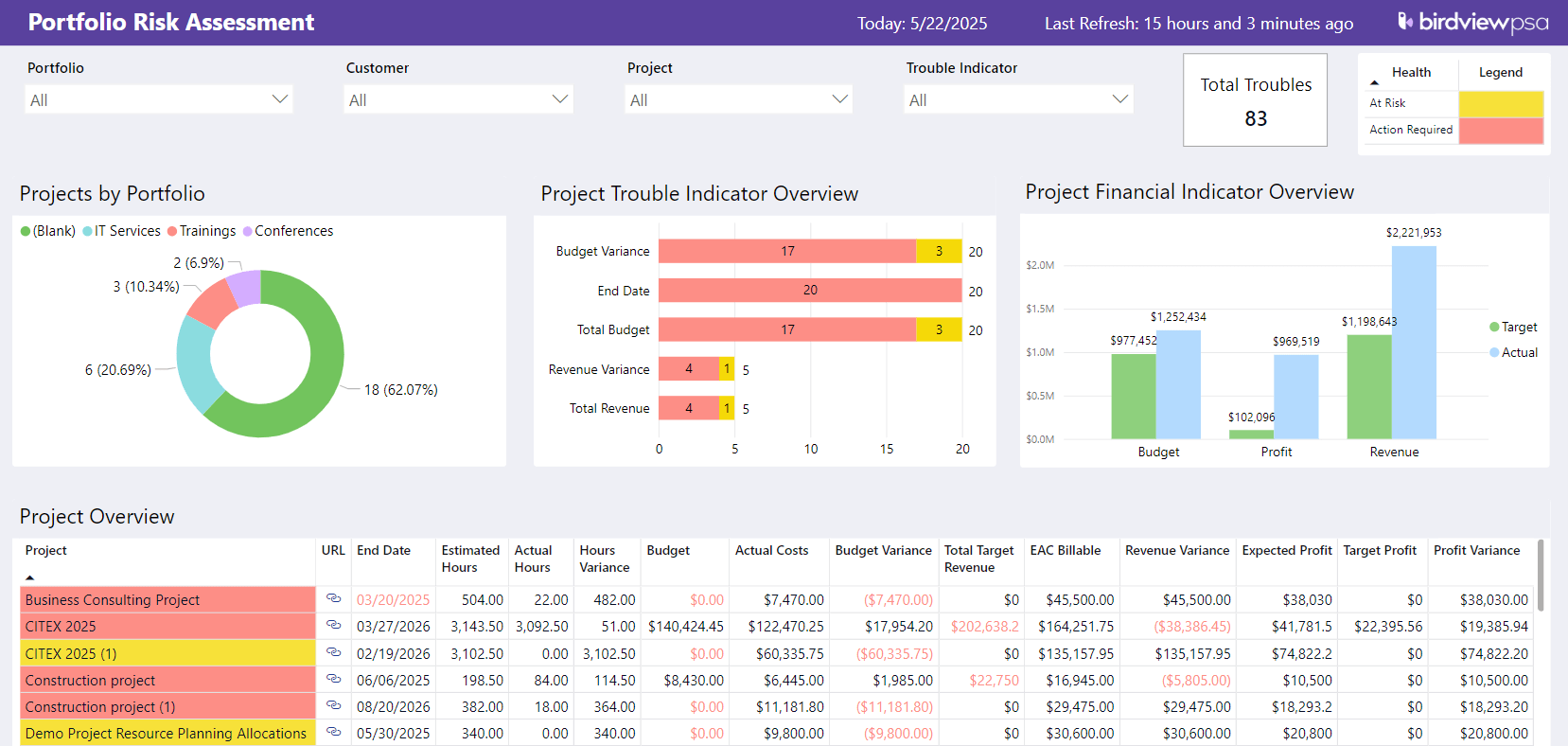Project Portfolio Management (PPM) helps you focus on what matters most by aligning projects with strategy, prioritizing resources, and reducing delivery risks. It involves evaluating the potential benefits of projects, including those that are currently underway or planned for the future. In this guide, you’ll learn what PPM is, why it matters, and how Birdview PSA supports project portfolio success from planning to execution.
In this article
What is a project portfolio?
A project portfolio is a group of different projects managed together to improve planning and management. This approach helps an organization manage resources, schedules, and goals more effectively. Unlike individual projects that aim to achieve a specific result, a portfolio’s goal is to continuously manage and allocate resources across several projects.
What is the purpose of project portfolio management?
Project portfolio management, or PPM for short, is about seeing the bigger picture. Instead of looking at just one project at a time, it helps you manage all your projects together – like a portfolio of investments. The main purpose? To make sure your organization is doing the right projects, not just doing them right.
Imagine you‘re running five or ten projects at once. Some are big, some are small, and some are just ideas on paper. Without a system, it‘s hard to know which ones are most important, which are draining resources, or whether they all support your company‘s goals. PPM helps you step back and evaluate them as a group.
The real goal of project portfolio management is to align projects with your business strategy. That means making sure your time, money, and people are focused on work that moves the company forward. It‘s not just about delivering projects on time – it‘s about choosing the projects that are worth delivering.
For example, let‘s say your engineering firm has limited capacity and multiple client requests. PPM helps you prioritize projects that are most profitable, most urgent, or most strategic – and defer or cancel those that aren‘t. It also helps you spot overlaps, manage risks across projects, and reallocate resources if one project starts to slip.
In simple terms, PPM helps you:
-
Choose the right projects
-
Balance resources across teams
-
Track progress and performance at a higher level
-
Adapt when priorities change
Without PPM, teams often chase urgent work without thinking about value. With it, leadership can make smarter decisions, avoid overload, and keep everyone aligned on what matters most.
So, the purpose of project portfolio management isn‘t just better project execution – it‘s smarter business planning, using projects as tools to reach your goals.
Why project portfolio management matters
Project Portfolio Management is crucial because it helps ensure that all projects are in line with the company‘s key goals and that each project adds value toward reaching those goals. It enables organizations to focus on the most important projects by providing the needed resources and attention. This focus helps improve the return on investment for each project. Furthermore, PPM gives a complete view of all projects, making it easier to manage risks and spot problems early.
This approach supports better decision-making by understanding how each project affects the company’s broader objectives. It ensures that any deviations from the planned budget, schedule, or scope are corrected quickly, reducing negative impacts.
How companies benefit from project portfolio management
Project Portfolio Management is crucial for organizations that manage multiple projects at the same time. It offers a comprehensive framework for prioritizing, monitoring, and enhancing a collection of projects by consolidating them into a single portfolio. This consolidation facilitates the easy review and tracking of each project‘s progress, ensuring projects are executed effectively.
1. Portfolio management simplifies project decision-making
Project Portfolio Management transforms project coordination and decision-making, streamlining the process by encouraging teamwork and the open exchange of ideas. This approach significantly speeds up solution finding, diverging from the conventional model where communication flows linearly from team members to the project manager, and then to executives, and back.
Consider the evolution of communication in project management: traditionally, a hierarchical structure limits direct interaction across different levels. PPM, however, enables direct and fluid communication across all team members, leveraging technology for broader collaboration. This method not only enhances project transparency but also encourages contributions from various departments, such as marketing insights beneficial to accounting or design tips that can aid marketing strategies. By centralizing data in a cloud-based system, you get easy access to historical project information, facilitating informed decision-making and promoting a self-sufficient approach among team members.
2. Project portfolios reduce project risks and enhance project productivity
Furthermore, Portfolio Management plays a crucial role in reducing project risks and boosting productivity. By preemptively addressing potential delays, communication barriers, and resource allocation issues, PPM lowers the likelihood of project hiccups. It employs analytical tools to evaluate and prioritize projects based on risk, thereby improving project outcomes and organizational efficiency.
3. Utilizing project portfolios minimizes project overruns
One of the significant advantages of Project Portfolio Management is its capability to prevent budget overruns and excessive resource use. Through the application of estimation tools that draw on historical data and project scope, PPM makes accurate cost predictions, mitigating financial oversights.
4. Project portfolios reduce project completion time
PPM also contributes to reducing project timelines. It eliminates the common question among team members, “What should I be working on next?” by clearly defining tasks and schedules. This clarity and organization can shorten project durations by an average of 10%, optimizing both short and long-term project execution.
5. PPM decreases duplicative or low-value projects while increasing the overall value of the portfolio.
Additionally, it aids in refining the project portfolio by eliminating redundant or low-value initiatives. It consolidates projects into a unified database, allowing for a comprehensive review and prioritization based on strategic value and potential return on investment (ROI). This process ensures that resources are allocated to projects that align with the organization’s goals and offer the highest returns.
Which industries are enhanced by project portfolio implementation?
In summary, Project Portfolio Management equips organizations with the tools and methodologies to enhance decision-making, resource allocation, risk management, and overall project execution, driving efficiency and value across the project portfolio.
Project Portfolio Management is utilized across various industries to enhance project outcomes, ensure alignment with business goals, and optimize resource allocation. Here‘s how PPM benefits different sectors:
Engineering and IT Services Companies: These firms leverage PPM to ensure projects are in line with business objectives, efficiently allocate resources among competing projects, and enhance collaboration across departments, teams, and stakeholders. IT companies, in particular, prioritize projects based on customer needs, technology trends, and internal capabilities, aiming to increase profitability and guarantee customer satisfaction through timely delivery.
Business Consulting and Professional Services: Companies in these sectors use project portfolios to align projects with goals and optimize the deployment of experts across projects to lower risks. Project managers prioritize tasks and assign personnel based on their skills, experiences, and client preferences, incorporating insights from previous projects to inform current and future initiatives.
Marketing Services: Businesses offering marketing solutions apply PPM to organize campaigns effectively, prioritizing based on resource availability, budget limitations, customer significance, and the potential for maximum return on investment (ROI).
Overall, Project Portfolio Management enables organizations across these varied industries to minimize unexpected delays, prioritize projects intelligently, allocate resources efficiently, mitigate risks, and sequence projects for optimal success.
📚 Read more: Industries That Benefit Most From Project Management Software
7 steps of an effective project portfolio management process
Managing a project portfolio requires more than just overseeing multiple projects. It demands a structured approach that aligns every initiative with your organization‘s goals. Below are seven essential steps that form the foundation of a successful project portfolio management process, from setting goals to analyzing results.

1. Identify your business’s primary goals
For service-oriented companies, determine whether the main focus is to offer top-notch services or to provide the most competitive rates. When low rates are a priority, initiatives aimed at reducing costs take precedence over those intended to improve service quality.
2. Collect and evaluate project ideas in detail for your portfolio
Every project undergoes a detailed assessment to estimate its feasibility, potential risks, and expected benefits. This includes both ongoing projects and project concepts that are similar enough to be managed together. Collect data on project management and establish criteria for evaluation to select the most suitable options.
3. Choose the most suitable projects for your portfolio
Selecting projects that align best with the organization’s goals and resource capabilities involves creating a list of criteria for evaluating each project. Factors such as cost, resource availability, and risk level can influence project evaluation criteria.
4. Prioritization of projects in the portfolio and sequence of actions
Selected projects are prioritized based on various criteria. This step determines the sequence in which projects are initiated and how resources are allocated among them to achieve maximum impact.
5. Resource allocation and optimizing the team‘s workload
This step involves distributing resources across the chosen projects. It’s a balancing act to ensure each project is allocated the necessary funding, personnel, and equipment. Ensure you have the resources to balance your workforce and complete the tasks efficiently.
6. Execution, delivery, and oversight of projects in the portfolio
With resources allocated, the focus shifts to executing the projects within the portfolio. This phase involves closely monitoring each project’s progress against its objectives, timelines, and project budgets, ensuring projects stay on track and making real-time adjustments as necessary.
7. Project completion, analysis, and understanding results
Upon completing a project, conduct a review to assess how the project’s outcomes have contributed to strategic objectives. This phase is also crucial for capturing lessons learned and best practices for continuous improvement in managing future projects.
The responsibility for managing, monitoring, and optimizing the project portfolio rests with the Project Portfolio Manager, ensuring the entire process aligns with the organization’s strategic goals and maximizes project success.
The role of the project portfolio manager
The Project Portfolio Manager is pivotal in project management, responsible for overseeing and fine-tuning the project portfolio to ensure each project contributes to organizational success.
Responsibilities include:
- Evaluating: Evaluating and assessing projects for their value, necessary resources, and potential impact to set their priority within the portfolio.
- Resource Allocation: Distributing resources like budget, staff, and equipment across projects to enhance overall portfolio performance.
- Risk Management: Identifying and strategizing against potential portfolio risks.
- Decision Making: Making informed choices about initiating, continuing, or concluding projects based on their alignment with organizational goals.
- Monitoring Progress: Keeping a close watch on project performance within the portfolio to ensure they’re on track.
- Stakeholder Communication: Keeping stakeholders updated on portfolio status, addressing issues, and maintaining decision-making transparency.
- Lessons Learned: Analyzing completed projects to extract valuable insights for refining future project processes and decisions.
What‘s the difference between a project manager and a portfolio manager?
The question often arises: What is the difference between the responsibilities of a project manager and those of a project portfolio manager?
To answer briefly, a project portfolio manager oversees a collection of projects, aligning them with the business’s strategic goals and optimizing the distribution of resources across the portfolio. Conversely, a project manager is focused on the successful execution of a single project, managing its scope, budget, schedule, and team to meet specific objectives.
Project Manager vs. Project Portfolio Manager
| Project Manager | Project Portfolio Manager | |
| Primary Focus | Manages a single project | Oversees a group of related or unrelated projects (a portfolio) |
| Objective | Ensures the project is delivered on time, within scope, and on budget | Ensures all projects in the portfolio align with business strategy and deliver maximum value |
| Scope of Work | Narrow – focused on one project‘s execution | Broadly focused on prioritization, resource allocation, and strategic alignment across multiple projects |
| Key Responsibilities | – Managing scope, timeline, and budget
– Coordinating tasks and the team – Reporting progress to stakeholders |
– Prioritizing and evaluating project proposals
– Aligning projects with business goals – Balancing resource demand across the portfolio |
| Resource Management | Manages resources within their own project | Oversees resource distribution across multiple projects |
| Decision-Making | Makes tactical decisions for project delivery | Makes strategic decisions about which projects to initiate, pause, or cancel |
| Stakeholder Communication | Communicates with project-specific stakeholders | Communicates with executives and senior stakeholders across the organization |
| Performance Metrics | Project performance indicators (on-time, on-budget, within scope) | Portfolio-level KPIs (ROI, risk exposure, strategic value, capacity utilization) |
| Tools Used | Project planning, task management, and Gantt charts | Portfolio dashboards, resource forecasting, and prioritization tools |
Can a project manager simultaneously perform the duties of a project portfolio manager?
Regarding whether a project manager can also handle the duties of a project portfolio manager, it is indeed possible for an individual in this role to take on the responsibilities of managing a project portfolio in addition to their project-specific tasks.
What tools are needed to manage a project portfolio?
To manage a project portfolio effectively, you need more than just task lists or timelines. You need tools that give you the full picture – across all projects, people, and priorities.
First, you need strategic planning tools to decide which projects to take on and how they align with your business goals. These help you make smarter choices and avoid taking on too much at once.
Second, resource management tools are key. They show you who‘s available, who‘s overloaded, and how best to assign people across different projects. Without this, it‘s easy to burn out your team or run into delays.
Third, you need real-time tracking and performance dashboards. These give you visibility into how each project is progressing, whether you’re on budget, and where risks might be forming.
And finally, collaboration and communication tools keep everyone aligned. When teams, clients, and leadership can access the same information and updates, decisions get made faster and with less confusion.
That‘s why most teams use project portfolio management software like Birdview PSA. It combines all of these tools into one platform – helping you plan better, allocate smarter, and deliver results across your entire portfolio.
With the right tools in place, you don‘t just manage projects – you manage outcomes.
What to look for in PPM software
Choosing the right Project Portfolio Management (PPM) software is critical for aligning project execution with your organization‘s strategic goals. The ideal tool should go beyond managing individual projects. It should offer visibility, control, and agility across your entire portfolio.
1. Portfolio-level visibility
Your software should provide a centralized view of all active, planned, and completed projects. This enables leadership to assess overall performance, spot risks, and track how projects contribute to your company‘s objectives.
💡 Useful tip: Use real-time dashboards and portfolio views to monitor health, budget, and resource status across multiple projects.
2. Smart resource planning
PPM software must make it easy to assign and balance resources based on availability, workload, and project priorities. This helps avoid overallocation and burnout.
💡 Useful tip: Visual workload heatmaps and resource loading reports help you spot capacity gaps and redistribute work efficiently.

3. Scenario planning and forecasting
Effective PPM tools help you run what-if scenarios, forecast capacity, and model the impact of adding, pausing, or shifting projects before making major decisions.
💡 Useful tip: Built-in forecasting and capacity planning tools let you explore scenarios and anticipate bottlenecks before they impact delivery.
4. Integrated time and cost tracking
Tracking time, budgets, and expenses is essential for understanding true project performance and portfolio ROI.
💡 Useful tip: Time tracking, expense logging, and budget reports are all built-in, making it easier to monitor profitability and financial health across the portfolio.
5. Customizable dashboards and reports
PPM software should support tailored reporting for different roles–executives need high-level KPIs, while project leads may need detailed progress and workload data.
💡 Useful tip: Customize dashboards by role, department, or stakeholder group to ensure everyone gets the insights they need.

6. Collaboration and communication features
Strong PPM tools bring your teams together with shared views, notifications, and communication tools that reduce friction and confusion.
💡 Useful tip: Keep teams aligned with shared calendars, in-app discussions, status updates, and centralized project documentation.
7. Scalability and integration
The best PPM software should grow with you. Look for platforms that integrate with your existing CRM, accounting, or collaboration tools.
💡 Useful tip: Integrate with platforms like QuickBooks, CRM tools, and other business systems to unify project and financial data in one place.
Common pitfalls in project portfolio management and how to avoid them
Managing a collection of projects, known as project portfolio management, can be tricky, and even seasoned managers can slip up. Here are some typical errors that can happen when handling multiple projects:
❌ Not matching projects with company goals: A big mistake is not ensuring that the projects fit with what the company wants to achieve in the long run. This can lead to working on projects that don‘t help the company grow.
✅ Solution: Birdview lets you group projects into portfolios and tag them based on business goals, so every initiative is aligned with your organization‘s priorities from day one.
❌ Wrongly assigning resources: It‘s easy to give too much to one project and not enough to others, leading to delays and poor quality work. Balancing how resources are spread out is crucial.
✅ Solution: Birdview‘s workload views and resource loading reports let you see how work is distributed across teams in real time, making it easy to reassign or redistribute resources before issues arise.
❌ Not planning for problems: Failing to spot and plan for potential issues can catch a team off guard. It‘s important to think about what could go wrong and have a plan just in case.
✅ Solution: Birdview enables you to monitor key trouble indicators, track dependencies, and adjust timelines or resources proactively with built-in forecasting and timeline planning tools.
❌ Not figuring out which projects are most important: treating all projects as equally important can waste time and resources. Some projects need to be finished first because they are more crucial to the company‘s success.
✅ Solution: Use Birdview‘s prioritization features and portfolio dashboards to rank and sort projects by value, risk, effort, or strategy fit.
❌ Forgetting to talk to everyone involved: not keeping in touch with everyone who has a stake in the project, like team members or customers, can lead to misunderstandings and projects not meeting expectations.
✅ Solution: Birdview offers role-based visibility, comment threads, and shared dashboards to keep all stakeholders informed and engaged throughout the project lifecycle.
❌ Ignoring how projects affect each other: not seeing how one project can impact another can cause problems with timelines and resources. It‘s important to understand these relationships.
✅ Solution: Birdview allows you to visualize multiple projects in a single portfolio view, track cross-project dependencies, and plan holistically, ensuring one delay doesn‘t derail everything.
❌ Lack of clear communication: not sharing information clearly and regularly can lead to confusion and mistakes. Good communication helps everyone stay on the same page.
✅ Solution: Centralize communication in Birdview with built-in collaboration tools, shared calendars, real-time updates, and project activity feeds, all in one place.
❌ Being too rigid: not being willing to adjust plans when things change can make it hard to take advantage of new opportunities or deal with unexpected problems.
✅ Solution: Birdview‘s drag-and-drop Gantt charts and flexible scheduling tools let you adapt plans on the fly, without losing track of timelines, budgets, or dependencies.
❌ Not using the right tools: not taking advantage of software that can help manage projects can make the job harder than it needs to be. These tools can offer insights and help keep everything organized.
✅ Solution: Birdview PSA combines portfolio management, resource planning, workload balancing, and real-time reporting in one platform, eliminating tool sprawl and data silos.
❌ Not learning from past projects: missing the chance to learn from past mistakes and successes can prevent improvement. It‘s important to look back at what worked and what didn‘t and use that knowledge moving forward.
✅ Solution: Use Birdview‘s reporting and BI dashboards to track project outcomes, identify trends, and create a feedback loop for ongoing process improvements across your portfolios.
Avoiding these pitfalls requires being open to change, learning from experience, and being ready to adjust how things are done based on new information.
How Birdview PSA helps with project portfolio management
Managing a project portfolio manually or with scattered tools can lead to delays, missed priorities, and resource misallocation. Birdview PSA software provides a centralized platform to organize, prioritize, and execute projects efficiently across portfolios, ensuring strategic alignment and operational control.
Here‘s how Birdview PSA supports effective PPM at every stage:
1. Centralized portfolio structuring
How Birdview helps: Birdview PSA lets you group and manage projects in structured portfolios using customizable criteria such as Client, Department, Project Lead, or Industry.
Benefit: This flexibility ensures that project managers and stakeholders can easily segment and navigate their portfolios for better oversight and reporting.
2. Real-time resource visibility across projects
How Birdview helps: With Birdview, all approved projects and resource schedules are visible in a single view, including capacity limits and availability updates.
Benefit: This allows for smarter project assignment and helps you avoid overcommitting key team members across different portfolios.
3. Smart prioritization and workload balancing
How Birdview helps: Birdview’s visual workload heatmaps and prioritization tools help you compare projects across value, urgency, and effort, and reallocate resources as needed.
Benefit: You stay agile and ensure top-priority initiatives are staffed appropriately while preventing burnout from overallocation.
4. Integrated capacity planning for the future
How Birdview helps: With time off, resource constraints, and project scope built into one forecasting view, you can plan long-term capacity with confidence.
Benefit: You can avoid over-promising, plan future initiatives realistically, and respond quickly to shifting priorities.

5. Dynamic dashboards and reporting across portfolios
How Birdview helps: Monitor project health, KPIs, and progress at the portfolio level using customizable dashboards and BI reports.
Benefit: Leaders can make informed decisions faster and spot performance gaps across any project group.
Why choose Birdview PSA for your project portfolio management needs?
Project Portfolio management software is now essential for project managers. Birdview goes beyond traditional project management software by offering features for managing and optimizing an entire project portfolio in one place. It allows you to see, assess, and efficiently distribute resources among your projects. With Birdview, you can swiftly set priorities and assign projects and tasks, making it a potent tool for both project and portfolio management.
Group projects into organized portfolios and manage projects with confidence.
Categorize projects into structured portfolios using specific criteria such as Clients, Industry/domain, Project Lead, and Team function/department.
Prioritize and provide teams and stakeholders with access to portfolio data.
Tailor visibility for team members, enable managers to monitor progress and set priorities, and share updates with customers. Birdview stands out as a top-tier project and portfolio management tool, offering a full suite of benefits to enhance your business operations.
Capturing the full range of Birdview’s features and capabilities as a project portfolio management tool is quite challenging.
Access instant insights into performance metrics
Monitor every project’s advancement and each team member’s output using our portfolio tracking tool to:
Identify and avert potential scheduling or task distribution issues, oversee resource distribution, and maintain schedule adherence to prevent hold-ups.
This comprehensive approach to project portfolio management not only streamlines project execution and resource allocation but also enhances decision-making, risk management, and overall project and portfolio success, positioning organizations to achieve their strategic objectives and maximize their return on investment in projects.
Contact us to see how Birdview PSA brings clarity and control to your entire project portfolio.
You may be interested in...
Birdview Ranked in Top 10 Project Portfolio Management by GetApp
4 Essential Steps of Project Portfolio Optimization
Best Project Portfolio Management Software 2025
Best Enterprise Project Management Software 2025
Frequently Asked Questions
What is the main goal of project portfolio management (PPM)?
The primary goal of PPM is to ensure all projects align with the organization‘s strategic objectives while maximizing resource efficiency and overall value. It helps prioritize high-impact initiatives, manage risk, and allocate resources effectively across multiple projects.
How is a project portfolio different from a single project?
A single project focuses on achieving a defined outcome within a set timeline and scope. A project portfolio, on the other hand, is a collection of multiple projects managed together to optimize performance, resources, and alignment with business goals.
What types of companies benefit most from PPM?
PPM is valuable for any organization that runs multiple concurrent projects. It‘s especially beneficial in industries like professional services, IT and software development, engineering, marketing services, and consulting, where prioritization, resource capacity, and delivery timelines are critical.
How does Birdview PSA support project portfolio management?
Birdview PSA helps you group projects into structured portfolios, prioritize initiatives, manage cross-project resources, monitor real-time progress, and generate insights through dynamic dashboards. It centralizes your portfolio data, making it easier to align execution with strategy.
Can Birdview help manage resource capacity across multiple projects?
Yes. Birdview PSA offers visual tools like workload heatmaps and resource loading reports that let you monitor and balance team capacity across all active portfolios. This ensures resources are not overbooked or underutilized.
Is it possible to track KPIs and performance across portfolios in Birdview?
Yes. Birdview PSA includes customizable BI dashboards and real-time reporting that allow you to track project health, budget status, and performance metrics across portfolios.
Can Birdview PSA support approval workflows for portfolio changes?
Yes. Birdview allows teams to automate workflows for new project approvals, resource requests, or changes to portfolio structure, ensuring accountability and consistency.



